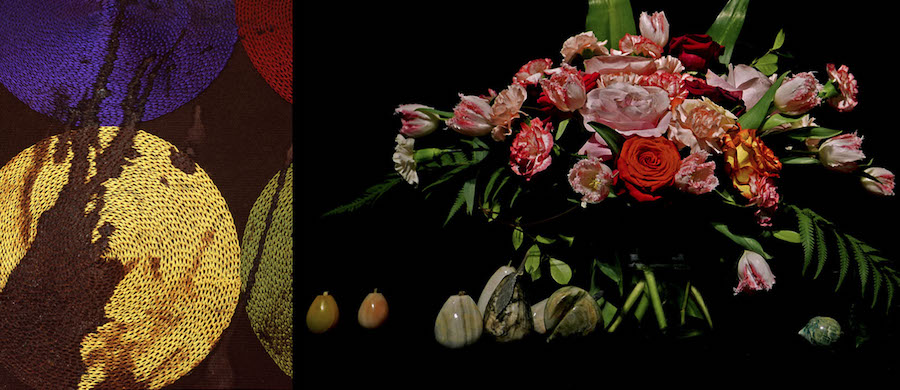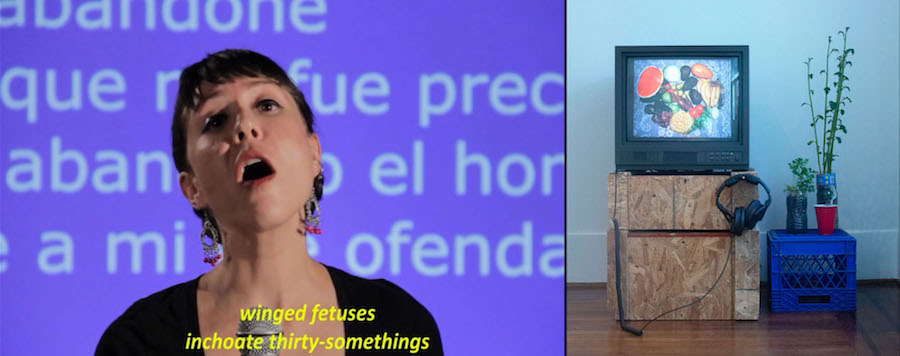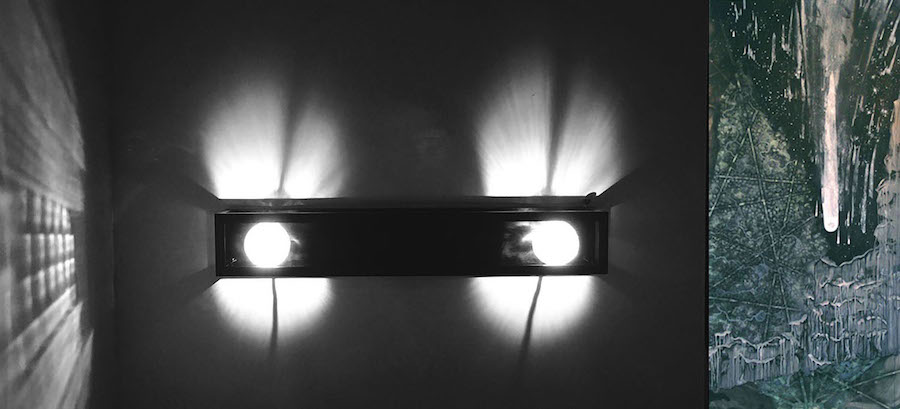Para leer este artículo en español, por favor vaya aquí. To read this article in Spanish, please go here.
My fellow Houston artists: Allow me to offer a proposal for creating a new museum for Hispanic, Latino/a/x, Mexican-American art (for the sake of this short essay, I will alternate between various self-identifying terms). This new museum would be where I live now, in Houston. Why Houston? Unlike other major cities in Texas and around the country, Houston does not have an art museum or institution dedicated to our culture, despite the fact that our peoples make up 45% of Houston/Harris County region’s population.

(L) Sarah Sudhoff, Murder, Male, 40 years old (I), 2010. Archival Pigment Print, 40 x 30 inches. (R) Debra Barrera, Quintanilla, Rosa, 2018. Archival pigment print.
La Primavera (Springtime) has seen a new awakening of Latino/a/x art exhibitions, projects and displays like never before. Much of this coincided with the Latino Art Now! 2019 conference at the University of Houston held this past spring. Artists, art spaces, theaters, non-profits, museums and galleries made a concerted effort to showcase this culture and talent throughout April and May. As encouraging and affirming as this is, I can’t help but sense that the satisfaction is fleeting. By summertime, we’re back to a reality where studies show how Latino/a/x artists and art organizations historically receive less than 1 percent of total arts funding from the city, state and federal levels combined. What do we do about maintaining our imprint on Houston’s arts and culture scene beyond La Primavera de 2019?
I will not belabor the various reasons why a Latino/Hispanic art museum in Houston does not exist. Instead I propose what a new institution can represent, and paint for you a vision for it.
The vision is an inclusive one, involving all Spanish-speaking nationalities (Mexican-Americans make up 75% of the Hispanic population of Harris County) with their arts and culture from multiple disciplines, representing all genders and ages. It will include historic artifacts, with past and contemporary art. Most importantly, it would be a collecting institution that will purchase, commission, contextualize, exhibit, store, record, promote, preserve and conserve all that encompasses and comprises our arts and culture.

(L) Leo Tanguma, Rebirth of Our Nationality, 1973 and 2018. 240ft, 5900 Canal street, (with Gonzo247). (R) Angel Quesada, El indio de la guardia, 2016. Corner of Leland and St. Emmanuel, 30’ x 30’.
It will focus primarily on the work made here in this region from its past and current populations. The MFAH has done an admirable job of interspersing a few works by national Chicano artists within their Latin American exhibitions. But we need a museum that will concentrate and have the responsibility over a collection of art produced primarily in Harris County and the surrounding regions. We have great resources, cultures, culture-makers from this region who deserve the same attention and scholarship as other global cultures enjoy.
Where in Houston should this organization be based? Our historic Mexican-American neighborhoods on the East Side and North Side can make serious claims for hosting it. But our Houston origins are complex. Our families have moved to, settled and resettled in different neighborhoods over time. Spring Branch or Southwest Houston, with their proliferating Latino communities, are potential bases for the museum. There’s no need to be overly territorial about where the place is built. The greater challenge is the community coming together on its establishment. If it were up to me, I would build it along Buffalo Bayou, platformed on stilts, with clear views of the city skyline. Its presence there could cultivate a brand-new arts district outside of the current, well-funded Museum District.

(L) Julia Barbosa Landois, Star-Crossed II, 2013. Video still, 6:30 minutes. (R) Francis Almendarez, Nuestro Hogar (installation view), 2019. Multimedia with produce plants, dimensions variable.
Inclusiveness is the key. Historic civil rights groups (for example the N.A.A.C.P. and the American G.I. Forum) established a general principle about their memberships: the ethic is you don’t have to look or be exactly like us to be part of the organization. If you believe in the mission, you can become a member. This same ethic should carry over to whom and what art this museum shows. We have a diverse and growing population from the various Spanish-speaking countries. Works by any of them could be included. This new institution must include art from people of different sexual orientations and non-binary identifications. Essentially, the new museum should not be another space for only straight men’s art. A new museum will recognize and celebrate people of all genders and identities within our communities. Their omission would turn into a farce, and create the same historic mistakes other museums have made and continue to make. This new museum should be an example of inclusivity and equality that all other national institutions can takes notes from.
We must ensure that the Houston cultural centers of Multicultural Education and Counseling through the Arts (MECA) and Talento Bilingüe de Houston (TBH) are secure, financially stable and made sustainable over the long-term. When building a new museum, let’s avoid the problems other cities face with competing Hispanic, Latino/a/x institutions. New institutions can lead to competition for resources and politically contentious relationships. We need centers like MECA and TBH to thrive while we build a new museum. Museums and cultural centers are a democratizing force. The more the better.
There’s plenty of money out there to help establish the museum. A new institution is possible by harnessing our population’s financial clout, seeking partnerships with the various regional and neighborhood chambers of commerce and the Hispanic Chamber of Commerce, the county and city government, as well as corporate, non-profit, multiple endowments, trusts and funding mechanisms. The time for this has come. We are 45% of the population. Other visions are currently on the table, such as Museo Guadelupe Aztlan, the Hispanic Archives of the Houston Public Library, and the Institute for Hispanic Culture. Fresh ideas abound for more cultural centers, with spaces providing for the performing arts and civic dialogues. Valuable discussions about our “cultural capital” being held across the city demonstrate the constituency is here and the currency is growing.
Artists must have a seat at the table during the creation of the museum. While a board of trustees is responsible for the fiduciary stability of the institution, the aesthetic vision and goals must be built by people of expertise. A new artist advisory board (with maximum inclusivity and equality) must work in parallel with the board. Emerging artist organizations have formed, such as MANTECA HTX (the online line artist registry and events/program calendar) and the Houston Alliance for Latinx Arts (HALA). Each flexes our cultural muscles, creates new art networks, highlights issues of advocacy, and impacts the entire arts scene of the region. Artists (the term is used broadly) cannot be taken for granted in establishing a new cultural institution. Artists must be valued from the start, and their contribution to the serious dialogue of its formation and development ensures the credibility and long-term vibrancy of any arts institution.

(L) Moe Penders, Volvo P1800, 2019. Volvo headlights from 1963-1971, multi-media. (R) Ariel Masson, Iron Bones, 2003. Acrylic and ink on paper, 120″ x 52.
These ideas are not exclusively mine. I’ve spoken with and heard from a variety of people, and consulted many museum directors, arts administrators and non-profit professionals about their experiences. There are many models for how Latino and Mexican-American culture centers are being formed across the state and the country. All of our various visions can be combined into a force that makes a new museum in Houston a reality. We can come together through ideas of its function and accessibility — around the very necessity of finally having a museum that collects our art. This is an ambitious and expansive vision. All the various Spanish-speaking nationalities, artists, civic and business leaders, curators, administrators, educators and our fellow citizens (young and mature), neighborhoods and communities can confer with each other. It should be accredited by the American Alliance of Museums, have a functioning board of trustees, an artists advisory board, an executive director responsible to the boards, curators, and conservators, who works with program managers to build a consistent level of programing throughout each year. A new museum must maintain the structure and professionalism to do all of these things while helping to create a new cultural face for the region.
La Primavera of Latino/a/x art is a momentous time to begin the serious discussion and organization for how and what a new Hispanic/Latino/a/x/Mexican-American museum in Houston should be.
What shall we call it? Let’s tread thoughtfully on this idea: Houston’s “El Museo de las Americas?” “Nuestro Museo de Houston?”
Henry G. Sanchez is a Houston-based artist and a contributor to Glasstire. Sanchez is the founder and director of L.O.C.C.A: Law Office Center for Citizenship and Art and the BioArt Bayoutorium.




11 comments
“There’s plenty of money out there to help establish the museum.” I think you skip over this a bit too breezily. You need people to write some very big checks to get something like this started–the 6 (and 7) figure kind. Before such a museum even begins, it will need a huge capital campaign and endowment fund-raising. Do you have deep-pocketed donors in mind?
I wrote this article to set out a vision and an ethic for a future museum. It is not a budget plan. We can create a baseline of principles for how this new museum can operate before ever seeking a penny of “money”. In the meantime, please send some me names who can write big check and maybe the community of people who are interested in starting this new institution (not just me) can organize to capitalize on this.
It’s a good, legitimate vision Henry!
This is something that is long over due. Houston has the potential to lead a potent Latinx art scene. Let’s make this happen. Love this article.
I agree!
Wonderful essay Henry! Thank you for vision and passion.
Undoubtedly you have penned a most inclusive and compelling vision for a first class institution that has been missing in Houston. I applaud it, second it, and look forward to doing the inclusive work with many others towards bringing this vision to life. It is imperative that Latinx artists in the nation have an institution/place that works for them.
Beautiful job Henry! While long overdue, this idea has become more pertinent than ever. I also agree that there is a lot of will out there for this, and I applaud your article for being a part of the very necessary critical work needed to make this salable.
Thanks Henry for the articulation of this wonderful vision, and yes, long overdue because of Houston demographics and geographic location. Viva the Museum of Latin American Art!
Henry, you are riGht a Hispanic Museo De Houston is long over due. I suggest you form a committee of Houston Hispanic movers and shakers and make two lists. The first list a list of donors ( Individual, private and corporate) to financially seed the project and the second a list of collectors of Hispanic art who may donate their collection to El Museo. Lastly in naming it pay attention to the acronym. I hope you don’t mind my input. 🙂
Museo Guadalupe Aztlan, founded in March 1994 from our humble home at 314 Cosmos, Houston, Texas, continues to make strong strides in terms of creating a Chicano/a-Latino museum for our city. After Thanksgiving, for example, we resume our “Cafe Con Cuauhtemoc Museum Apprenticeship Program,” which is in its third phase this year. Contact us to learn more: [email protected].
-Jesus Medel